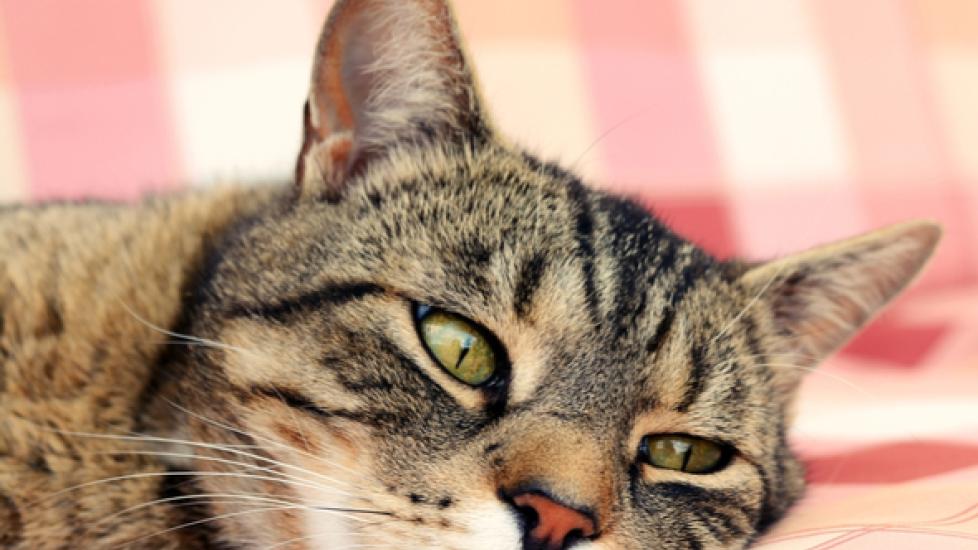Treating Upper Respiratory Infections in Cats
By Dr. Sandra Mitchell, DVM
“Please, I need to get my kitty in right away for an exam. She has runny, swollen eyes and is sneezing constantly. Can she be seen today?”
This is an almost daily call to most veterinary hospitals. Unfortunately, respiratory infections in cats are extremely common. Fortunately, however, severe illnesses that are secondary to them are not often seen.
The kitties who are most prone to upper respiratory infections are those exposed to a lot of other cats (like kids in a kindergarten class!). This can happen in shelters or catteries—often these cats are somewhat crowded and stressed, which lowers their immune functioning.
Compounding the situation is the fact that many of these cats may be unvaccinated or under-vaccinated, which also means they have little to no protection against many of the agents causing respiratory infections in cats. This sets the situation up for a firestorm—with contagious agents able to spread through virtually the entire population.
What Causes Upper Respiratory Infection in Cats?
The most common causes are two viruses—the feline herpesvirus and the feline calicivirus. Together, these make up almost 90 percent of the infections we see. There are a few other agents, including feline chlamydiosis, mycoplasma and Bordetella—and some cats may be infected with more than one respiratory infection virus.
Fortunately, there are tests that can be done by your veterinarian to help narrow down the cause of the infection. These diagnostic tests are often done with severely affected cats or when lots of cats have been exposed.
How Do You Know If Your Cat Has a Respiratory Infection?
A sneezing cat or a coughing cat can signal an upper respiratory infection. Some of the other common symptoms may include a discharge from the nose or eyes, sniffling, a fever (often evident by a lack of appetite), a hoarse meow (or no voice at all) and ulcers in the mouth or on the nose.
When Should You Bring Your Cat in for a Vet Visit?
Most upper respiratory infections in cats will resolve themselves with a little extra TLC and time. However, more severe infections may require treatment, prescription pet medication or even hospitalization.
As a rule of thumb, a sniffly kitty that is still eating, active and feeling fine can be watched for a few days. If the cat is not eating, seems listless or is congested enough that she needs to open her mouth to breathe—it is certainly time for a trip to the veterinary hospital.
Although most of these infections are viral in nature, sometimes cat antibiotics are indeed indicated to protect against secondary bacterial infections or to treat potential primary bacterial infections, such as feline chlamydiosis and Bordetella. Your veterinarian can help to determine if antibiotics are needed or likely to be helpful.
Remember, antibiotics do NOT treat viral infections whatsoever, so for simple, routine upper respiratory infections in cats, they are not indicated.
Can You Comfort Your Cat Without Going to the Vet?
If your kitty is lethargic, not eating or breathing with its mouth open, she really does need to be seen immediately by a veterinarian. However, if she is eating and stays active, a little supportive care may help her to feel much better.
Feeding canned cat food is not only healthy, but it is a little less scratchy on the throat going down. Also, if kitty is quite congested, warming the food slightly or adding warm water as a gravy will make it smell more appealing and help entice your cat to eat.
Bringing the cat into the bathroom while you take a warm shower can also help loosen up some of the congestion—like a giant, humid steam bath—and help to make kitty more comfortable.
As far as any over-the-counter drops or supplements are concerned, these are generally not helpful or necessary, unless specifically recommended by your veterinarian for a specific case/reason. Most upper respiratory infections run their course in about 10-14 days.
However, some kitties do suffer from chronic infections and are then prone to periodic flare-ups or ongoing congestion. These are the exception rather than the rule.
We consider upper respiratory infections in cats to be very contagious, and it is not uncommon for a normal-looking kitten to be adopted from a shelter, only to start sneezing within a few days, followed shortly by all of the other cats in the house.
Minimizing the Severity of Upper Respiratory Infections in a Group of Cats
If you are bringing home a new cat that may be infected, there are a few things you can do to try to slow the spread of upper respiratory infections to the other cats in your home.
First, fully vaccinate all of the cats in the household, preferably before that new kitten or cat comes home.
Keep the new cat in a quarantine area away from the other cats in the household for 10-14 days while she adjusts. This not only lets you watch for signs of disease in the new cat, but also reduces stress levels for everyone as they slowly become acquainted.
Wash items such as food bowls and litter scoops with bleach during this time period. Always be sure to take care of the new cat last and change clothes after your visit. Good preventative care and minimizing stress will go a long way towards keeping everyone healthy.
The vast majority of cats make a rapid, full recovery if diagnosed and treated appropriately early.
